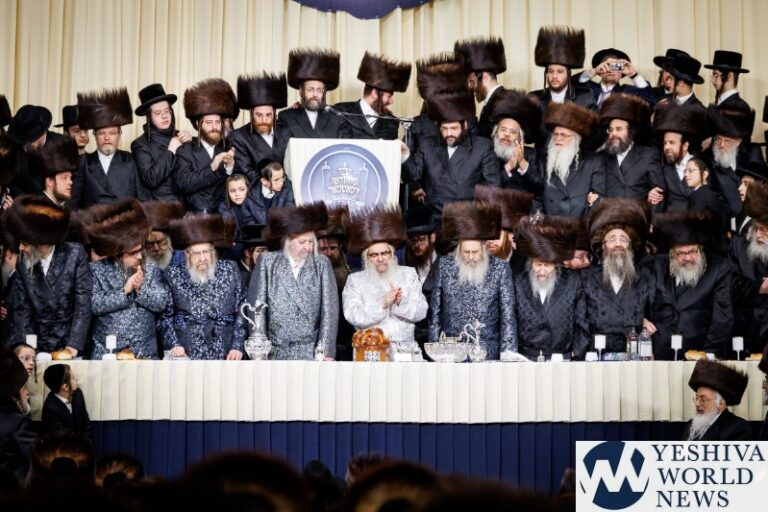By Rabbi Yair Hoffman
There is a fascinating halacha that applies to expectant mothers of which many of us may not be fully aware. But first, a quick overview.
According to recent statistics, there are over 4000 mani-ped salons in New York City and its immediate environs alone. The very first one was started in 1878 on West 23rd Street in Manhattan. It was started by an early female entrepreneur named Mary Cobb and was called, “Mrs. Cobb’s Manicure Parlors.” Back then, they charged $1.25 for a manicure. Within a decade, her business was thriving, her clientele ranging from socialites to celebrities to, well, let’s just leave it as, the less yeshivesh of New York society.
Until the past fifty years, however, it seems that it was not the norm for most observant Jews to get mani-pedis at a salon. Rather, these matters were tended to on ones own.
In the 1970’s, there was an influx of Korean immigrants to New York City who, in the words of author, Suzanne Shapiro, “took something that was once a luxury and drove the price down.” Her book is called, ““Nails: the Story of the Modern Manicure.”
It seems that, in the vast commercialization of nail salons, a time-saving measure among the manicurists was enacted to just “let the nail clips go flying all over the place.” Prior to this, normative practice was to carefully put the clips away. The newer development , however, seems to be problematic for expectant mothers according to the Gemorah in Nidah 17a:
The Gemorah tells us that one who cuts his nails and throws them into a public area is accountable for his soul. The Gemara explains that this is dangerous because a pregnant woman might pass over them, and this can cause her to miscarry. The Gemorah initially thought to limit this halakha to the following:
- only when one removes his nails with scissors [bigenosteri]
- only when one removes the nails of his hand and his foot together
- only when he did not cut anything else after his nails, but if he cut something else after them, we have no problem with it.
However, the Gemara concludes with the comment that, ultimately, this is not true and that we are concerned in all cases.
HOW TO DEAL WITH THEM
With regard to removing one’s nails, the Gemorah further taught: “Three matters were stated with regard to removing nails: One who burns them is pious, as he eradicates them entirely; one who buries them is on the slightly lower level of a righteous individual, as they might be dug up; and one who simply throws them where a person might step upon them is wicked.”
It would seem that burying them is on a slightly lower level because there is a chance that the nail could somehow resurface. There are commentaries, however, who provide explanations that the nails are indicative of of mosros – excess and that it is a statement of affirming a life of spirituality over a life where one pursues just luxuries.
THE REASON FOR THE PROHIBITION
Regardless, it may be interesting to explore the following two questions. What is the reason for this prohibition, and why is it an issue that seems to be taken so seriously by chazal?
- Both the Ran (Rav Nissin ben Reuvain, 1320 – 9th of Shevat, 1376) and the Nemukei Yoseph (a Spanish Talmudist who flourished in the 14th and 15th centuries and lived in Barcelona) in their respective commentaries on Moed Kotton 18a, explain that it is either because the women are disgusted by it or because it is on account of witchcraft. For the more scientifically bent individuals the explanation might be that these two things could precipitate a higher level of progesterone levels in the blood which may lead to spontaneously aborting the fetus, r”l. In the culture of that time, people were particularly sensitive to this and perhaps progesterone levels were dangerously high on account of such fears.
- The Tolaas Yaakov, however, explains that Adam haRishon was originally entirely covered with fingernails. Only after he sinned, it was completely removed from him. Since it was his wife who precipitated it, there is a concern that she may be punished with it.
- In the Ben Yehoyada, it is explained that the outer powers stick to the nails and thus cause damage to the foetus, since the nails just continue to grow (which is why we look at them on Motzai Shabbos). The mazikim then damage the foetus as a midah k’neged midah.
DIFFERING TEXTS
May a man step over these nails? From the Gemorah it seems that it would not be a problem. The Gemorah in Moed Kotton also seems to indicate that it is not a problem, because according to our version of the Gemorah, Rav Yochanan would even throw them in the Beis Medrash. The Shla, however, had an alternative text in the Gemorah in Moed Kotton, where he threw them in the Bais HaKiseh [the bathroom] and not the Beis Medrash.
THE ZOHAR TEXTS
The Bach (Yore Deah 198) cites the Rokayach that a menstruant women who is not careful with her nails receives punishment. Thus it would seem that men should also avoid it. There is a Zohar in Parshas Acharei Mos 79b which states that whomsoever steps on nails can get damaged. It is clear that the Zohar learns that either the nails or the victim can be a male as well. There is yet an additional Zohar which indicates the same thing that is found in Parshas Vayakhel (page 208b).
Rav Tzvi Hirsch Kaidanover (1648-1712), author of the Kav HaYashar writes that it is still a problem even when the person walking is wearing shoes.
THE SOLUTION
So how should this issue be resolved? Some women actually make sure that the salon workers actually sweep up the area prior to their sitting down in the salon chair. Surprisingly, most salon owners comply with such requests.
The author can be reached at [email protected]












5 Responses
A little-known fact (which even rabbonim are unaware of):
The Gemara in Nidah 17a (stated in article above) speaks of MEN disposing of their nails, not women.
The sakana for a women to step on nails only applies to the nails of men – not women’s nails.
This can be inferred from (one of) the reason (as stated in the article) of the Ran and Nimukei Yossef on Moed Kotton 18a, that it is because the women are disgusted by it
– it is logical, and sometimes logic is the strongest source – as stated:
למה לי קרא? סברא הוא! (ב”ק מ”ו ב’, נידה כ”ה א’)
that a woman is more disgusted by men’s nails than those of a woman (as women a. have an inherent beauty and b. generally care for the appearance of their nails).
Furthermore, there are many items listed in the Gemarah that cause negative consequences, yet we are no longer concerned with them. Therefore, this “danger” listed in the Gemarah may no longer apply.
I note that the חתם סופר (יו”ד קא) even says this about the danger of eating fish with meat but we keep this as a custom!
משום דחזינן לרמב”ם דרב גוברי ברפואות וטבעיות שהשמיט הנ”ל, על כן ניסה בחקירתו ומצא שנשתנו הטבעים בזה. והשתא נהי (= ועכשיו נניח) שלא נסמוך על זה לעשות מעשה לאכלם זה עם זה, דאפשר דהוי כמו דבר הנאסר במניין, ואפשר דלא שייך בזה כל הני תירוצים הנאמרים בגילוי ומשום כך אנו נזהרים, ומנהג אבותינו תורה
As other examples:
הוריות יג ב that eating olives causes one to forget his learning – yet who refrains from eating olives or olive dips?!
נידה יז leaving overnight a peeled onion, garlic or egg, even in a sealed container “מתחייב בנפשו ודמו בראשו”
מסכת תרומות, פרק ח’, משנה ד’: שלושה משקין אסורין משום גילוי: המים והיין והחלב and the GR”A writes
גם אם בטל הטעם לא בטל הדין
Magen Avraham O.C. 271:1 not to make kiddush between the hours of 6 p, and 7 pm.
Bais Yossef Yoreh De’ah 87:3 not to eat fish with milk (no lox and cream cheese)!?
There are many other examples.
The esteemed and learned author omitted that the Gemarah specifically states that if the nails were moved from their original dropped location – they no longer pose a problem. This detail – that moving the nails absolves all danger, is inconsistent with the explanations for the danger listed in the article and requires explanation!!!
(Regarding “moving” the nails, I am aware that Mishnah Berurah cites the Elyah Rabba who feels that the danger is only removed if the nails are moved to an entirely different room. If, however, they are moved within the room they still are dangerous. The Chida (Birkei Yosef 260:6) rules in accordance with the Prisha – in any event, how would merely moving the nails remove the reasons of the danger listed in the article?!).
Also the esteemed and learned author omitted to mention that neither the Rambam nor Tur and Shulchan Oruch include such a halacha in their Code of Jewish Law! Clearly, they did not consider this Gemarah as a halacha!!!
(I am aware that later poskim DO mention it – such as Magen Avraham 260 and Mishna Brurah 260, 6, but it begs the question, why did the codifiers of halacha omit this ruling – unless they considered it not valid?!)
BTW – query: Does this concern also apply to nail clippings of a non-Jew?
(Relevancy: In a Diaspora city, the majority of people are non-Jews, hence the majority of the clipping in a manicure salon are from non-Jews, therefore if a Jewish nail clipping is among them, Halacha itself rules that it is bottel b’rov!)
However, Rivevot Ephraim 8:88:1 ….says yes, the ruling applies also to nail clippings of non-Jews!
Rav Steinman ZTZ”L writes that he asked the Chazon Ish how come we don’t see women miscarrying due to a lack of diligence and knowledge of these laws (of stepping on nail clippings)?
The Chazon Ish replied that as we are living in a time of Hester Panim there is ‘static’ between us and the spiritual powers associated with these dangers and there is therefore less of a risk.
The Aruch Hashulchan (OC 260:6) writes that these (laws regarding nail clippings) are not halachic obligations rather one who is careful should be, and one who is not doesn’t have to start.